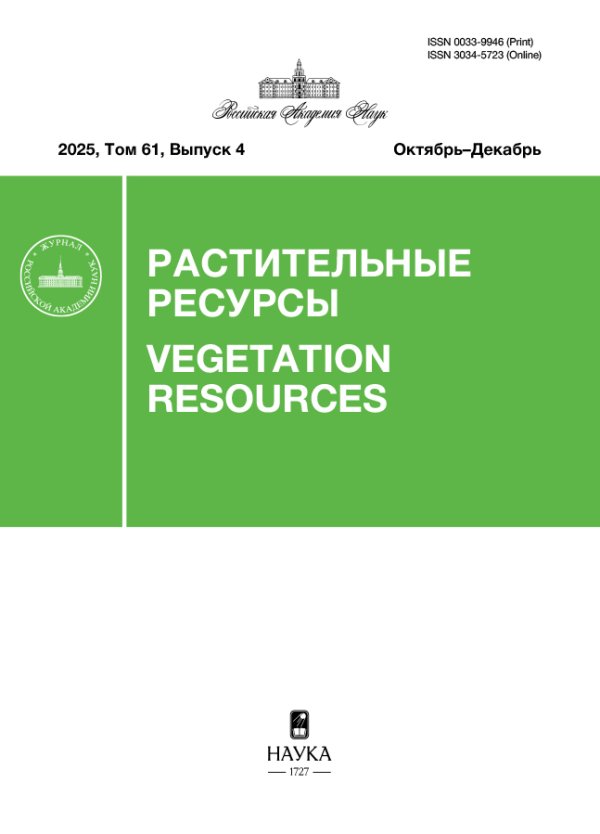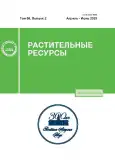Comparative Analysis of the Component Composition of Flowers in Some Species of the Genus Syringa (Oleaceae)
- Authors: Pupykina K.A.1, Polyakova N.V.2, Kudashkina N.V.1, Krasyuk E.V.1
-
Affiliations:
- Bashkir State Medical University
- South Ural Botanical Garden-Institute, Ufa Federal Research Center of the Russian Academy of Sciences
- Issue: Vol 59, No 2 (2023)
- Pages: 152-163
- Section: Component Composition of Resource Species
- URL: https://journals.rcsi.science/0033-9946/article/view/138784
- DOI: https://doi.org/10.31857/S0033994623020103
- EDN: https://elibrary.ru/ZNMJET
- ID: 138784
Cite item
Full Text
Abstract
Abstract
—Due to the insufficient knowledge of the lilac flowers component composition, a comparative analysis of 6 species of the genus Syringa L. from the collection of the South Ural Botanical Garden-Institute of the Ufa Federal Research Center RAS was carried out. S. emodi Wall., S. josikaea Jacg., S. komarowii Schneid., S. reticulata (Blume) H. Hara ssp. amurensis (Rupr.) P.S. Green et M.C. Chang, S. sweginzowii Koehne et Lingelsh, S. vulgaris L. were studied. The content of the major groups of biologically active compounds, namely flavonoids, hydroxycinnamic acids, tannins and organic acids, was established. The highest content of all identified groups of biologically active substances (BAS) was found in flowers of S. komarowii: flavonoids ‒ 4.25 ± 0.21%, hydroxycinnamic acids ‒ 6.13 ± 0.29%, tannins – 9.3 ± 0.5%, ascorbic acid ‒ 0.468 ± 0.022%, and organic acids ‒ 10.7 ± 0.5%. In S. emodi and S. sweginzowii the content of these BAS is little less than in S. komarowii, and the minimum amount of BAS was found in S. josikaea. A comparative analysis of the qualitative and quantitative profiles of the BAS major groups in some lilac species cultivated in the Republic of Bashkortostan shows the prospects for their further study with the objective of their possible use in scientific medicine, and for the development of herbal remedies.
About the authors
K. A. Pupykina
Bashkir State Medical University
Email: bloomerang11@gmail.com
Russia, Ufa
N. V. Polyakova
South Ural Botanical Garden-Institute, Ufa Federal Research Center of the Russian Academy of Sciences
Author for correspondence.
Email: bloomerang11@gmail.com
Russia, Ufa
N. V. Kudashkina
Bashkir State Medical University
Email: bloomerang11@gmail.com
Russia, Ufa
E. V. Krasyuk
Bashkir State Medical University
Email: bloomerang11@gmail.com
Russia, Ufa
References
- Belikov V.V., Kolesnik N.T. 1989. [A method for the quantitative determination of flavonoids in plant materials: USSR author’s certificate No. 1507394, MKI A 61 K 35/78]. № 34. (In Russian)
- The State Pharmacopoeia of the Russian Federation XIV ed. 2018. https://femb.ru/record/pharmacopea14 (In Russian)
- Zhurikhina L.N., Bondaruk A.M., Kapustin M.A., Svintilova T.N., Tsygankou V.G., Halavach T.N., Kurchenko V.P. 2017. Comparative toxicological and hygienic assessment of clathrates of β-cyclodextrine and hydroxypropylene β-cyclodextrine with ferulic acid on Tetrahymena pyriformis. – In: [Health and environment]. 27: 91–94. http://rspch.by/Docs/v27_sbornik.pdf (In Russian)
- Klimova I.Yu. 2005. [Analytical and technological research on the development of new drugs based on the bark of common lilac: Abstr. … Diss. Cand. (Pharmacology) Sci.]. Samara. 24 p. (In Russian)
- Kravchenya E.S., Tarun E.I., Kurchenko V.P. 2019. Antioxidant activity extracts of the crust of different types of lilac (Syringa). – In: [Sakharov Readings 2019: Environmental problems of the XXI century. Proc. of the 19th intern. sci. conf.]. V. 2. Minsk. P. 92–95. https://elib.bsu.by/handle/123456789/230511 (In Russian)
- Kurkin V.A. 2013. [Medicinal plants as a source for import-substituting drugs]. – Farmatsevticheskiye Nauki. 8: 139‒142. (In Russian)
- Kurkin V.A. 2015. Phenylpropanoids as the most important group of biologically active compounds of medicinal plants]. – International J. Applied and Fundamental Research. 12(7): 1338‒1342. https://applied-research.ru/ru/article/view?id=8148 (In Russian)
- Kurkin V.A., Ryazanova T.K., Serebryakova A.D. 2021. [The comparative study of the chemical composition of the above-ground organs of common lilac (Syringa vulgaris L.)]. – In: [90 years – from plant to drug: achievements and prospects. Proc. of intern. sci. conf.]. Moscow. P. 237‒244. http://doi.org/10.52101/9785870191003_2021_237 (In Russian)
- Kurchenko V.P., Rizevskiy S.V., Esaulenko M., Tsygankov V.G., Bondaruk A.M., Filonyuk V.A., Spiridovich E.V. 2017. Composition and content of biologically active substances in the bark of various species of the lilac (syringa) introduced in the central botanical garden of the National academy of science of Belarus. – In: Role of Botanical Gardens and Arboretums in conservation, investigation and sustainable using diversity of the plant world. Proc. Int. Conf. Minsk. P. 249‒255. https://www.elibrary.ru/item.asp?id=29775622 (In Russian)
- Pastushenkov L.V., Lesiovskaya E.E. 1994. [Pharmacotherapy with Phytotherapy Fundamentals: A Textbook for Medical and Pharmaceutical Schools]. St. Petersburg. 159 p. (In Russian)
- Polyakova N.V., Kucherova S.V. 2008. [Dust accumulation properties of common lilac (Syringa vulgaris L.) in urban ecosystems]. – In: [Urboecosystems: problems and development prospects: Proceedings of the III International scientific and practical conference]. Ishim. P. 139‒140. http://ruconf.ru/upload/iblock/de5/433c0f86660f2409e5dbf312302ec2a6.pdf (In Russian)
- Polyakova N.V., Putenikhin V.P., Vafin R.V. 2010. [Lilacs in the Bashkir Cis-Urals: introduction and biological features]. Ufa. 170 p. (In Russian)
- Polyakova N.V. 2016. [Integral assessment of the prospects of species of the genus Syringa L. in the collection of the Ufa Botanical Garden]. – In: [News of the Ufa Scientific Center of the Russian Academy of Sciences]. 3: 70‒73. https://www.elibrary.ru/item.asp?id=26586399 (In Russian)
- Polyakova N.V. 2021. Introduction of a protected species Hungarian lilac (Syringa josikaea Jacg.) in the South Ural. – Izvestiya Vuzov. Severo-Kavkazskii Region. Natural Science. 1: 122‒126. http://doi.org/10.18522/1026-2237-2021-1-122-126 (In Russian)
- Serebryakova A.D., Kurkin V.A. 2020. The development of approaches to the standardization of Syringa vulgaris leaves. – Aspirantskiy Vestnik Povolzhiya. 1–2: 158–163. https://doi.org/10.17816/2072-2354.2020.20.1.158-163 (In Russian)
- Sokolov S.Ya., Zamotaev I.P. 1993. [Handbook of medicinal plants. Phytotherapy]. Kharkov. 241 p. (In Russian)
- Sokolov S.Ya. 2000. [Phytotherapy and Phytopharmacology: A Guide for Physicians]. Moscow. 976 p. (In Russian)
- Spiridovich E.V., Shabunya P.S., Bashilov A.V., Zubarev A.V., Garanovich I.M., Bulyka S.E., Hrynkevich V.G., Reshetnikov V.N. 2017. Selection estimation of syringin content in the representatives of the Lilac genus (Syringa L.) in the Central Botanical Gardens of the National Academy of Sciences of Belarus. – Doklady of the National Academy of Sciences of Belarus. 61(6): 80–88. https://doklady.belnauka.by/jour/article/view/477 (In Russian)
- Dudek M.K., Michalak B., Woźniak M., Czerwińska M.E., Filipek A., Granica S., Kiss A.K. 2017. Hydroxycinnamoyl derivatives and secoiridoid glycoside derivatives from Syringa vulgaris flowers and their effects on pro-inflammatory responses of human neutrophils. – Fitoterapia. 121: 194‒205. https://doi.org/10.1016/j.fitote.2017.07.008
- Jin L., Sun J., Jin M., Jin C., Diao S., Zhou W., Gao Li. 2020. Chemical constituents from Syringa reticulata (Bl.) Hara. – Biochemical Systematics and Ecology. 89: 103986. https://doi.org/10.1016/j.bse.2019.103986
- Kikuchi M., Yaoita Y., Mano N., Kikuchi M. 2010. Glycosides from the leaves of Syringa vulgaris and their growth inhibitory activity against human cancer cell lines. – Shoyakugaku Zasshi: The Japanese J. Pharmacognosy. 64(2): 104‒105. http://dl.ndl.go.jp/info:ndljp/pid/10758447
- Su G., Cao Y., Li C., Yu X., Gao X., Tu P., Chai X. 2015. Phytochemical and pharmacological progress on the genus Syringa. – Chem. Cent. J. 9: 2. PMCID: PMC4312558 https://doi.org/10.1186/s13065-015-0079-2
- Tóth G., Barabás C., Tóth A., Kéry A., Béni S., Boldizsár I., Varga E., Noszál B. 2016. Characterization of antioxidant phenolics in Syringa vulgaris L. flowers and fruits by HPLC-DAD-ESI-MS. – Biomed. Chromatogr. 30(6): 923‒932. https://doi.org/10.1002/bmc.3630
- Woźniak M., Michalak B., Wyszomierska J., Dudek M.K., Kiss A.K. 2018. Effects of phytochemically characterized extracts from Syringa vulgaris and isolated secoiridoids on mediators of inflammation in a human neutrophil model. – Front. Pharmacol. 9: 349. https://doi.org/10.3389/fphar.2018.00349
- Yan Y., O W., Zhao X., Ye X., Zhang C., Hao J., He H., Zhu X., Xu H., Yang X. 2010. Effect of essential oil of Syringa pinnatifolia Hemsl. var. alashanensis on ischemia of myocardium, hypoxia and platelet aggregation. – J. Ethnopharmacol. 131(2): 248‒255. https://doi.org/10.1016/j.jep.2010.06.027
- Zhang J.F., Zhang S.J. 2007. An overview of the genus Syringa: phytochemical and pharmacological aspects. – Nat. Sci. J. Hainan. Univ. 2: 201–205.
Supplementary files













